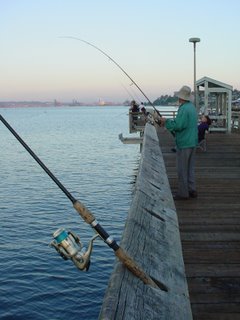 This is Chris, with his wife Shadi at his side, and our Baha'i friend Rose, who helped celebrate a going away party for two of our friends who are leaving to teach in China.
This is Chris, with his wife Shadi at his side, and our Baha'i friend Rose, who helped celebrate a going away party for two of our friends who are leaving to teach in China. Margie is leaving in a week to teach permanently, if all goes well. She's taught in China before, and this will be her third trip there. Margie loves the people in China, and most especially the children, who are very eager to learn English.
Margie is leaving in a week to teach permanently, if all goes well. She's taught in China before, and this will be her third trip there. Margie loves the people in China, and most especially the children, who are very eager to learn English. Tina will be working in the same city as Margie. She has worked here as a social worker, working with the homeless. As part of our evening gathering, there was a presentation on teaching in China by Amy, who lives and teaches there.
Tina will be working in the same city as Margie. She has worked here as a social worker, working with the homeless. As part of our evening gathering, there was a presentation on teaching in China by Amy, who lives and teaches there.
Amy was very touched by the spirit in the people of China, to have a good education, and especially to learn English. Many of the youth wish to learn English so they can do advanced coursework abroad when they get their degrees.
These ladies have been captivated by China's incredible history and its enduring culture. They look forward to participating in everyday life in China as well as contributing to the education of its people. Amy spoke about China's diverse climate and astounding natural beauty. She has made China her home, teaching in the same city for many years, getting to know the local people. She said she often visits the families, who invite her into their homes made of cinderblocks. Most of these are heated by a long hearth, called a 'Kang'. It is a long stone slab with a cooking hearth underneath. As the meal is being cooked, the hearth slab warms, and everyone sits on it to stay warm. It is also used for sleeping, when nights get quite cold. Amy said she once recalled temperatures of 40 degrees below zero, and this hearth, stoked with wood and cornhusks, was the only fuel.
There are particular challenges learning to live and work within this culture, where the history, culture, tradition and social system are different from ours. Considerable care must be taken to not promote religion, or to appear to be organizing into groups. When visiting with families and friends, Amy is careful to never have more than two people visiting at a time. As long as she consciously blended into the ways of the culture, she was able to acquire greater understanding of China and its people. She finds her work there so meaningful and has formed an inseparable relationship with China and the Chinese people. We hope Margie and Tina will enjoy their teaching experiences with the same kind of spirit.
Our daughter, Ruhiyyih, has gone to China twice to teach English, once for a year, and later as a course instructor, teaching the teachers how to teach. In fact, I started this blog just as she was leaving for China, with the hope it could help keep her in touch with us here at home....such was not the case, as most internet sites were off limits, with even phone calls and mail being monitored.
In the photo above, I showed Chris and Shadi, who were the first Baha'is we met when we first moved to Tacoma about 18 years ago. They made us feel so welcome, introducing us to their friends, and making our holidays special with so many gifts for our children.
 It truly does take special bonds of care and friendship to make someone feel at home in a new place. Rose, seated next to them, in that top photo, is from Iran, and is in the catering business. She provided much of the food for our celebration, and also chanted a prayer in Farsi, a most lovely and poignant contribution to our evening.
It truly does take special bonds of care and friendship to make someone feel at home in a new place. Rose, seated next to them, in that top photo, is from Iran, and is in the catering business. She provided much of the food for our celebration, and also chanted a prayer in Farsi, a most lovely and poignant contribution to our evening.























































